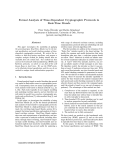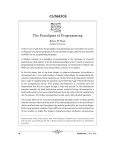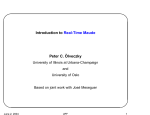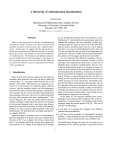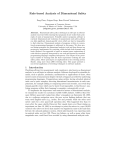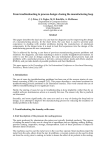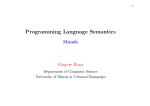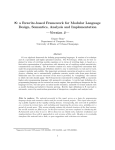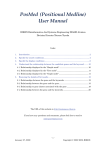Download ifi.uio.no
Transcript
Formal Analysis of Time-Dependent Cryptographic Protocols in
Real-Time Maude
Peter Csaba Ölveczky and Martin Grimeland
Department of Informatics, University of Oslo, Norway
{peterol, marting}@ifi.uio.no
Abstract
This paper investigates the suitability of applying
the general-purpose Real-Time Maude tool to the formal specification and model checking analysis of timedependent cryptographic protocols. We restrict the intruders so that they become non-Zeno, and propose a
complete analysis method for finding attacks that are
reachable from the initial state. Our method has been
used on the benchmark wide-mouthed frog (WMF) and
Kerberos protocols, on which we can find all the well
known flaws in short time. We use the WMF protocol to illustrate formal specification and the use of our
method to analyze timed authentication properties.
1
Introduction
Formal analysis based on model checking has proved
very useful to find subtle errors in cryptographic protocols. Consequently, there are many cryptographic protocol analysis tools based on formal methods (e.g., [9,
4, 10]). Such tools typically do not support modeling
and analyzing real-time aspects, and are therefore not
well suited to model time-sensitive cryptographic protocols such as Kerberos [7], wide-mouthed frog [1], and
TESLA [18].
In this paper, we investigate the suitability of using
Real-Time Maude [15, 14] for the formal specification
and analysis of time-sensitive cryptographic protocols.
Real-Time Maude is a high-performance tool that extends the rewriting logic-based Maude system [2] to
support the formal specification and analysis of objectbased real-time systems. Real-Time Maude emphasizes ease and expressiveness of specification, and provides a spectrum of analysis methods, including simulation through timed rewriting, time-bounded temporal logic model checking, and time-bounded and unbounded explicit-state search for reachability analysis.
Real-Time Maude has proved useful for analyzing a
wide range of advanced real-time systems, including
communication protocols [16] and scheduling [13] and
wireless sensor network algorithms [17].
The first problem we address is the extension of the
“Dolev-Yao” intruder model to the timed setting. To
justify the common and useful abstraction that state
transitions take zero time, a real-time system should
not allow “Zeno” behaviors in which an infinite number of such transitions takes place in a finite time interval. A “naive” Dolev-Yao intruder, however, can create an infinite number of fake messages in zero time.
We therefore restrict the intruder so that it can perform at most N malicious actions per time unit. With
such a non-Zeno intruder, any time-bounded search and
LTL model checking command is guaranteed to terminate. We use this fact to define a mechanizable analysis
strategy, where we increase the intruder capability N
and/or the time bound in the analysis command after
each search and model checking command in which no
attack is found, and then execute the command again,
until the attack is found (or we run out of memory or
patience). The advantages of this method are that:
1. Completeness of the analysis is regained, in the
sense that any flawed behavior that can take place
from the initial state without time or intruder limits will eventually be discovered.
2. Time-bounded LTL model checking can be used
to analyze properties beyond reachability.
3. Search analysis becomes feasible with this method.
Indeed, none of the search analyses in this paper could find the attacks before memory was exhausted when we used a Zeno intruder.
4. The method can be fully automated.
We have tested our method on the benchmark widemouthed frog (WMF) protocol [1] and on the much
larger Kerberos protocol [7], and found all known flaws
in typically less time than in other analyses.
In this paper, we illustrate our methodology with
the formal specification and analysis of WMF. The
WMF protocol was proposed by Burrows as a simple
protocol for ensuring timed authentication, and has become something of a benchmark time-sensitive cryptographic protocol. WMF has previously been analyzed
by model checkers for crypto-analysis [3, 9]. Without
any ingenuity in the definition of initial states, our tool
could automatically discover all known faults within
minutes. Indeed, for the two faults mentioned in [3],
our method found the flaws faster than the backwards
symbolic reachability analysis reported in [3].
Another advantage of our approach compared to using domain-specific crypto-analysis tools is that we can
include the cryptographic protocol as a part of a larger
system, or in combination with other kinds of protocols, and that we can model much larger and complex
protocols for which Maude has proved useful in the
untimed setting [5]. Furthermore, our tool allows simulation for prototyping purposes, and provides expressive analysis features to allow model checking of a wide
range of properties beyond just reachability properties.
2
Real-Time Maude
A Real-Time Maude module specifies a real-time
rewrite theory (Σ, E, IR, TR), where:
• (Σ, E) is a membership equational logic [11] theory with Σ a signature1 and E a set of conditional
equations. The theory (Σ, E) specifies the system’s state space as an algebraic data type, and
must contain a specification of a sort Time modeling the time domain.
• IR is a set of labeled conditional instantaneous
rewrite rules specifying the system’s instantaneous local transitions, each of which is written
crl [l] : t => t′ if cond, where l is a label.
Such a rule specifies a one-step transition from
an instance of t to the corresponding instance of
t′ , provided the condition holds. The rules are applied modulo the equations E.2
• TR is a set of tick (rewrite) rules, having syntax
crl [l] : {t} => {t′ } in time τ if cond .
that model time elapse. {_} is a built-in constructor of sort GlobalSystem, and τ is a term of sort
Time that denotes the duration of the rewrite.
1 That is, Σ is a set of declarations of sorts, subsorts, and
function symbols (or operators).
2 E is a union E ′ ∪ A, where A is a set of equational axioms
such as associativity, commutativity, and identity, so that deduction is performed modulo A. Operationally, a term is reduced to
its E ′ -normal form modulo A before any rewrite rule is applied.
The initial states must be ground terms of sort
GlobalSystem and must be reducible to terms of the
form {t} using the equations in the specifications.
A class declaration
class C | att1 : s1 , ... , attn : sn .
declares a class C with attributes att1 to attn of sorts
s1 to sn . An object of class C in a given state is represented as a term < O : C | att1 : val1 , ..., attn : valn >
where O, of sort Oid, is the object’s identifier, and
where val1 to valn are the values of the attributes att1
to attn . In a concurrent object-oriented system, the
state, which is usually called a configuration, is a term
of the built-in sort Configuration. It has typically
the structure of a multiset made up of objects and messages. Multiset union for configurations is denoted by a
juxtaposition operator (empty syntax) that is declared
associative and commutative, so that rewriting is multiset rewriting supported directly in Real-Time Maude.
The dynamic behavior of concurrent object systems is
axiomatized by specifying each of its concurrent transition patterns by a rewrite rule. For example, the rule
rl [l] : m(O,w)
< O : C | a1 : x, a2 : O’, a3 : z >
=>
< O : C | a1 : x + w, a2 : O’, a3 : z >
dly(m’(O’),x) .
defines a family of transitions in which a message m,
with parameters O and w, is read and consumed by an
object O of class C. The transitions have the effect of
altering the attribute a1 of the object O and of sending
a new message m’(O’) with (least) delay x (see [15]).
“Irrelevant” attributes (such as a3, and the right-hand
side occurrence of a2) need not be mentioned in a rule.
Timed modules are executable under reasonable assumptions, and Real-Time Maude provides a spectrum of analysis capabilities. Real-Time Maude’s timed
“fair” rewrite command simulates one behavior of the
system up to a certain duration. Real-Time Maude’s
timed search command uses a breadth-first strategy to
search for states that are reachable from an initial state
t within time τ , match a search pattern, and satisfy a
search condition. The command that searches for one
such state is written
(tsearch [1] t =>* pattern such that cond
in time <= τ .)
For analyzing more advanced properties, Real-Time
Maude extends Maude’s linear temporal logic model
checker [2] to check whether each behavior “up to a
certain time” satisfies a temporal logic formula [15].
When the specification is non-Zeno, only a finite number of states can be reached from an initial state within
a given duration, ensuring that time-bounded model
checking terminates.
3
Analysis with Non-Zeno Intruders
A cryptographic protocol is usually analyzed in the
presence of “Dolev-Yao” intruders. Such an intruder
can participate in ordinary protocol runs, but can also
intercept, overhear, and redirect any message in transit, and can create fake messages with the knowledge
it has acquired. An intruder cannot decrypt encrypted
messages for which it does not know the decryption key,
but can use encrypted parts to create fake messages.
Model checking a cryptographic protocol typically
consists of characterizing the states in which the desired property has been broken, and then exhaustively
searching for the reachability of such a bad state from
an initial state that contains an intruder.
the maxActions/duration-pair (2, 4). And so the process continues with the pairs (3, 3), (2, 5), (3, 4), (4, 3),
(2, 6), . . ., until the attack is found. Theoretically, this
process covers all possible attacks—relative to a given
initial system state—while each single model checking/search command terminates. On the pragmatic
level, our time-bounded search commands with Zeno
intruders did not find the attacks below before memory was exhausted, and time-bounded temporal logic
checking cannot be performed at all with such an infinitary intruder. Using our strategy, Real-Time Maude
search could find all known flaws, as described below.
In addition, our analysis method can be fully automated, as each time-bounded command terminates.
4
3.1
To conveniently model and analyze real-time systems, most state transitions are assumed to be instantaneous (i.e., to take zero time). For this abstraction to
make sense, systems should be non-Zeno, in that only
a finite number of such transitions can be performed
in a finite time interval. However, a naive lifting of
a Dolev-Yao intruder to the timed setting can lead to
Zeno behaviors, as an intruder may repeatedly create
the same fake message at the same time.
We therefore propose a general method in which
an intruder is restricted so it can perform at most
maxActions number of transitions per time unit. In
that way, Real-Time Maude time-bounded search and
LTL temporal logic model checking commands are
guaranteed to terminate.
3.2
Overview of the WMF Protocol
Non-Zeno Intruders
A Complete Analysis Method for
Non-Zeno Intruders
We use a non-Zeno intruder and a time-bounded
search or LTL model checking command to search for
attacks from a given initial state. Such analysis is
incomplete for the given initial configuration, since it
cannot discover attacks that take longer than the time
bound and/or can only happen with an intruder that
can perform more than maxActions number of actions
per time unit. To regain completeness, we must repeat
the search or model checking command until the attack
is found, increasing the value of maxActions and/or
the time bound after each unsuccessful command. To
cover all such (maxActions, duration)-pairs, we suggest in a first step a simple “diagonalization” strategy,
where we first analyze the system for, say, maxActions
2 and duration 3. If the attack is not found, then
the search or model checking command is repeated for
The goal of the WMF protocol [1] is to allow two
principals A and B to exchange a secret key via a
trusted server S. The protocol should ensure timed
authentication on the part of the responder: the responder should know that the protocol was recently
initiated by the claimed initiator. The protocol is described as follows in the usual protocol notation:
A −→ S :
S −→ B :
A . {Ta , B, K}KA,S
{Ts , A, K}KB,S
In the first step, the initiator A sends to the server S
the message A . {Ta , B, K}KA,S , containing his identity
together with a message, encrypted with the key KA,S
shared between A and S, that contains the time the
message was created (Ta ), the identity of the desired
responder (B), and the secret key K that A wants to
establish with B. In the second step, the trusted server
forwards to B the message containing the current time
Ts , the identity of the initiator, and the suggested key
K, all encrypted with the shared key KB,S . In both
steps, the receiver of a message must check the timestamp to ensure that the message was recently sent.
There are two well-known modifications of this protocol. To avoid mirror attacks due to the similarities of
the messages, it has been suggested that the rank (init
or forward) is added to the messages, so the two messages become, respectively, A . {Ta , B, K, init}KA,S
and {Ts , A, K, forward}KB,S . In WMF, the responder does not authenticate himself, and it has been suggested that a “hand-shake” is added at the end of the
protocol to have mutual authentication [8].
4.1
Desired Properties
WMF is usually analyzed w.r.t. the following, increasingly weaker, properties:
Agreement: The responder B in a protocol run can
trust the identity of the apparent initiator A, that
A initiated a protocol run with B with the desire
to send the received key K, and that the run A
initiated corresponds to only one connection at B.
Non-injective agreement: As agreement, except
that one run initiated by A with B can result in
B being a responder to that run more than once.
Aliveness: When B is responder, apparently with A,
then A must previously have been running the protocol (but not necessarily with B!).
In addition, there is a recentness requirement to each
of the above requirements, which says that the two
principals’ runs must be recent to each other.
4.2
Some Underlying Assumptions
The clocks in the system are assumed to be synchronized. The assumptions about communication are less
clear. We use a very general model, and only assume
that a message takes at least time minDelay to travel
from source to destination. There is no upper bound
on the time it may take a message to arrive at the destination. Therefore, we also capture the possibility of
message losses. A constant delayLimit gives the limit
for recentness of a message. We assume that the intruder can also intercept messages which have traveled
for less time than minDelay, but that any message sent
from the intruder has a delay of at least minDelay.
5
Modeling WMF in Real-Time Maude
This section presents our specification of both the
original WMF protocol and the protocol extended with
ranks. The parts that are omitted in the rank-less
version are placed within thin square brackets ‘[’ and
‘]’. The entire specification, together with analysis
commands, is available at http://www.ifi.uio.no/
RealTimeMaude/Crypto.
We give an object-oriented specification of WMF.
Principals, who can play both the initiator and “responder” (or “receiver”) roles, are modeled as objects
of a class Agent. Honest principals belong to a subclass HonestAgent of Agent, while dishonest intruders
are objects of a subclass Intruder defined in Section 7.
The trusted server is an object of the class Server.
5.1
Some Data Types
Keys. The ith key suggested by an agent A is modeled abstractly by a term key(A, i). The key KA,S
shared by an agent A and the unique server is denoted
sharedKey(A, server). Since Oid is the built-in sort
for object identifiers, we declare keys as follows:
sort Key .
op key : Oid Nat -> Key [ctor] .
op sharedKey : Oid Oid -> Key [ctor comm] .
Connections. For convenient analysis, a node
stores the connections it has established, as well as the
time each connection was established. A connection
where key K was suggested, where A is the apparent
initiator and B the apparent responder, and which was
initiated/received at time τ , is modeled by the term
A <-> B with K atTime τ of sort Conx:3
sort Conx .
op _<->_with_atTime_ : Oid Oid Key Time -> Conx .
A multiset of Conxs can be defined in the usual way:
sort ConxSet . subsort Conx < ConxSet .
op empty : -> ConxSet .
op _&_ : ConxSet ConxSet -> ConxSet
[assoc comm id: empty] .
Messages.
An
initiator
message
A.{Ta , B, K, init}KA,S is modeled by a term
msg (A ; encrypt {Ta ,B,K,init}
with sharedKey(A, server)) from A to server
and the forward message {Ts , A, K, forward}KB,S by
msg (encrypt {Ts ,A,K,forward} with sharedKey(B,server))
from server to B
for server the name of the lone server. These messages
are declared as follows:
sorts [Rank] MsgContent EncrMsg .
[ops init forward : -> Rank .]
op ‘{_‘,_‘,_[‘,_]‘} : Time Oid Key [Rank] -> MsgContent .
op encrypt_with_ : MsgContent Key -> EncrMsg .
op msg_;_from_to_ : Oid EncrMsg Oid Oid -> Msg .
op msg_from_to_ : EncrMsg Oid Oid -> Msg .
5.2
The Class Declarations
Each object has a clock attribute denoting the
current time.
An Agent also has a multiset
wantedConxs of the names of the principals with whom
it wants to initiate a run of the protocol, and a set
establishedConxs of the connections (with keys) that
the agent considers to be established:
class Agent | wantedConxs : OidSet,
establishedConxs : ConxSet,
keyCtr : Nat,
clock : Time .
class HonestAgent .
subclass HonestAgent < Agent .
class Server | clock : Time .
op server : -> Oid .
--- name of key server
3 To save space, ‘Conx’ is used for ‘Connection’, and the ctor
attribute is henceforth omitted from constructor declarations.
5.3
The Instantaneous Dynamic Behavior
The instantaneous dynamic behavior of WMF is
modeled by three rules: (i) sending an initiator message, (ii) receiving the initiator message and forwarding the message, and (iii) receiving the forwarded messages. Notice that the establishedConxs attribute is
not a part of the protocol itself, and does not impact
the behavior of the protocol.
The following rule models the start of a run of the
protocol. An agent INIT has an object name RESP in
its wantedConxs set, and starts a run of the protocol
by sending an initiate message (to server) with least
delay minDelay:
vars O INIT RESP A B I : Oid . vars T T’ : Time .
var OS : OidSet . vars CS CS’ : ConxSet .
vars KEY K : Key . var N : Nat . var M : Msg .
var C : Configuration . var EncrMSG : EncrMsg .
var ENCRMSGS : EncrMsgSet .
rl [initiate_run] :
< INIT : Agent | wantedConxs : RESP ; OS, keyCtr : N,
establishedConxs : CS, clock : T >
=>
< INIT : Agent | wantedConxs : OS, keyCtr : s N,
establishedConxs : CS &
(INIT <-> RESP
with key(INIT, N) atTime T) >
dly(msg INIT ; encrypt {T, RESP, key(INIT, N)[, init]}
with sharedKey(INIT, server)
from INIT to server, minDelay) .
In the next rule, the server checks whether an initmessage is recent (T’ monus T < delayLimit, where
x monus y = max(x − y, 0)) and, if so, forwards the
corresponding message (with appropriate least delay)
to the intended responder. If the message is not recent,
it is just discarded:
rl [forward] :
(msg INIT ; encrypt {T, RESP, KEY[, init]}
with sharedKey(INIT, server)
from INIT to server)
< server : Server | clock : T’ >
=>
if (T’ monus T) < delayLimit then
--- recent message
< server : Server | >
dly(msg (encrypt {T’, INIT, KEY[, forward]}
with sharedKey(RESP, server))
from server to RESP, minDelay)
else
--- not recent; just discard message:
< server : Server | >
fi .
Finally, in the third rule, the intended “responder”
receives the forward message and, if it is recent, stores
the new connection as established:
rl [receive_final_msg] :
(msg (encrypt {T, INIT, KEY[, forward]}
with sharedKey(RESP, server))
from server to RESP)
< RESP : HonestAgent | clock : T’,
establishedConxs : CS >
=>
if (T’ monus T < delayLimit) then --- new connection:
< RESP : HonestAgent | establishedConxs : CS &
(INIT <-> RESP
with KEY atTime T’) >
else < RESP : HonestAgent | > fi .
5.4
Behavior in Time
The transmission time of a message can be any time
greater than or equal to minDelay. This implies that
there is no urgency in our model. Apart from this
aspect, we follow the techniques for object-based specification in [15], and define the tick rule as follows:
rl [tick] : {C} => {delta(C, T)} in time T .
The tick rule is nondeterministic in that time may advance by any amount. Before executing the specification, we must define a time sampling strategy to guide
the execution of the tick rule [15].
The function delta defines the effect of time elapse
in a system. It distributes over the objects and messages in a configuration [15], and applies to single objects by just increasing their clocks according to the
elapsed time, and to delayed messages by decreasing
the remaining delay:
eq delta(< O : HonestAgent | clock : T >, T’) =
< O : HonestAgent | clock : T + T’ > .
eq delta(< O : Server | clock : T >, T’) =
< O : Server | clock : T + T’ > .
eq delta(dly(M, T), T’) = dly(M, T monus T’) .
Our specification is parametric in the time domain,
which may be dense or discrete. We import the builtin module NAT-TIME-DOMAIN to define the sort Time to
be the natural numbers.
6
Analyzing WMF Without Intruders
This section illustrates how WMF can be simulated
and model checked in a non-hostile environment. To
capture all possible behaviors, we select the time sampling strategy that advances time by one time unit in
each tick rule application by giving the command (set
tick def 1 .). We define the constants minDelay
and delayLimit to be, respectively, 1 and 2, and define
the following initial states init1 and init3:4
subsort String < Oid .
--- agent names are strings
ops init1 init3 : -> GlobalSystem .
4 Parts
of specification and commands will be replaced by ‘...’
eq init1 =
{< "Alice" : HonestAgent |
wantedConxs : "Bob", keyCtr : 1,
establishedConxs : empty, clock : 0 >
< "Bob" : HonestAgent |
wantedConxs : "Alice", keyCtr : 1,
establishedConxs : empty, clock : 0 >
< server : Server | clock : 0 >} .
eq init3 =
{< "Alice" : HonestAgent |
wantedConxs : "Bob" ; "Charlie",
establishedConxs : empty,
clock : 0, keyCtr : 1 >
< "Bob" : HonestAgent |
wantedConxs : "Alice" ; "Charlie", ... >
< "Charlie" : HonestAgent |
wantedConxs : "Alice", ... >
< server : Server | clock : 0 >}.
In init1, two agents want to initiate contact with
each other. init3 has three agents, two of which want
to initiate two connections each. A node may initiate a run at any time. Furthermore, wantedConx is
a multiset, so that "Alice" can initiate contact with
"Charlie" either before or after contacting "Bob".
The following timed search command searches for a
state, reachable from init3, in which all the desired
connections have been established:5
(tsearch [1] init3 =>*
{< "Alice" : HonestAgent |
establishedConxs :
("Alice" <-> "Bob" with K1:Key atTime T1:Time) &
("Alice" <-> "Charlie" with K2:Key atTime T2:Time) &
("Bob" <-> "Alice" with K3:Key atTime T3:Time) &
("Charlie" <-> "Alice" with K4:Key atTime T4:Time) >
< "Bob" : HonestAgent |
establishedConxs :
("Bob" <-> "Alice" with K3:Key atTime T5:Time) &
("Bob" <-> "Charlie" with K6:Key atTime T6:Time) &
("Alice" <-> "Bob" with K1:Key atTime T7:Time) >
< "Charlie" : HonestAgent | ... >
< server : Server | clock : T11:Time >} in time < 4 .)
Real-Time Maude returned such a desired reachable
state (in 52 seconds).
We next analyze our specification w.r.t. the
strongest desired property: recent agreement. That
is, for each connection established by a responder,
there must have been a distinct, recent connection initiated by the corresponding initiator, and with the same
key values. Note that an agent may want to initiate more than one connection with some other agent.
We analyze recent agreement by searching for a state
in which there exists a pair of agents A and B for
which the recent agreement property does not hold,
namely, where B’s multiset of connections initiated
5 Terms
name:sort are variables declared on-the-fly.
by A cannot be matched to the initiated connections
of A. The following function recentAgrOK is defined
so that recentAgrOK(A, B, conxsA , conxsB ) is true if
each connection from A to B in conxsB can be matched
by the corresponding recent connection in conxsA :6
ceq recentAgrOK(INIT,
(INIT
(INIT
recentAgrOK(INIT,
RESP,
<-> RESP with K atTime T) & CS,
<-> RESP with K atTime T’) & CS’) =
RESP, CS, CS’) if recent(T, T’) .
--- no corresponding connection at the initiator:
eq recentAgrOK(INIT, RESP, CS, CS’) =
not (INIT <-> RESP in CS’) [owise] .
op _<->_in_ : Oid Oid ConxSet -> Bool .
eq A <-> B in ((A <-> B with K atTime T) & CS) = true .
eq A <-> B in CS = false [owise] .
op recent : Time Time -> Bool .
eq recent(T, T’) =
(T’ monus T) <= (2 * (delayLimit monus 1)) .
The following command checks whether it is possible to reach a state, in time < 5 from init3, where
there is a pair of agents for which the recent agreement
property does not hold:
(tsearch [1] init3 =>*
{C:Configuration
< O:Oid : HonestAgent | establishedConxs : CS:ConxSet >
< O’:Oid : HonestAgent | establishedConxs :
CS’:ConxSet >}
such that not recentAgrOK(O:Oid, O’:Oid,
CS:ConxSet, CS’:ConxSet)
in time < 5 .)
No such state was found (the search took 850 seconds;
checking state init1 within duration 50 took 100 seconds). WMF looks good in a non-hostile environment.
7
Specification of Non-Zeno Intruders
This section specifies the non-Zeno intruder for
WMF. Since an intruder can also participate in ordinary protocol runs, the Intruder class is a subclass
of Agent. In addition, an intruder has attributes for
storing the set of agent names it knows (agentsSeen)
and the set of encrypted message contents that it has
seen but could not decrypt (msgsSeen). Finally, an
intruder can only perform a malicious action when its
actionsLeft value is greater than zero:
class Intruder | msgsSeen : EncrMsgSet,
agentsSeen : OidSet, actionsLeft : Nat .
subclass Intruder < Agent .
6 The attribute [owise] (for “otherwise”) in the second and
fourth equations means that the corresponding equation can only
be applied when the first and third equations cannot be applied.
The intruder class has rules for receiving a forward
message in an ordinary protocol run (where it also
learns of a new agent name), for intercepting messages
of the two kinds, and for creating fake messages of both
kinds using the information it knows. Other actions,
such as overhearing a message, can be performed as a
combination of interception and message creation.
The rule for intercepting an init-message is
as follows, and can only be performed when the
actionsLeft value is greater than zero:7
crl [intercept_msg_1] :
dly(msg INIT ; EncrMSG from INIT to server, T)
< I : Intruder | agentsSeen : OS, actionsLeft : s N ,
msgsSeen : ENCRMSGS >
=>
< I : Intruder | agentsSeen : add(INIT, OS),
actionsLeft : N,
msgsSeen : ENCRMSGS ; EncrMSG >
if I =/= INIT .
In this rule, the intruder has learnt a name (INIT) and
an encrypted message content (EncrMSG). In our flexible communication model, an intruder can also intercept messages that are not yet “ripe” (dly(...,T)).
The rule for creating a fake forward message takes
any name A from the set A ; OS of known names and any
encrypted message content EncrMSG (without knowing
its rank) from the set of known contents, and sends a
fake message to A, pretending to be from server:
rl [fake_msg_2] :
< I : Intruder | actionsLeft : s N,
agentsSeen : A ; OS,
msgsSeen : EncrMSG ; ENCRMSGS >
=>
< I : Intruder | actionsLeft : N >
dly(msg EncrMSG from server to A, minDelay) .
Finally, we define how the passage of time affects an
intruder, namely, by increasing its clock and recharging
its actionsLeft attribute:
eq delta(< I : Intruder | actionsLeft : N,
clock : T >, T’) =
< I : Intruder | actionsLeft : maxActions * T’,
clock : T + T’ > .
8
Analyzing WMF with Intruders
We analyze WMF in a hostile environment using the
method given in Section 3. To the previous initial state
init1 we add a non-Zeno intruder object:
eq init1+Intruder =
{< "Alice" : HonestAgent | ... >
< "Bob" : HonestAgent | ... >
7 The term s N will match any number which is a successor
(s) of a natural number.
< server : Server | ... >
--- as before
< "Eve" : Intruder | wantedConxs : none, clock : 0,
establishedConxs : empty,
msgsSeen : noEncrMsg,
actionsLeft : 2, keyCtr : 1,
agentsSeen : none >} .
8.1
Analyzing WMF Without Ranks
We analyze the original version of WMF with respect to the weakest property, aliveness: if B has been
a responder in a protocol run allegedly initiated by A,
then A must previously have run the protocol. The following search command checks whether, from a state
init1+Intruder with "Bob" removed from the state, it
is possible to reach a state where "Alice" has established a connection initiated by the non-existing "Bob":
(tsearch [1]
{< "Alice" : HonestAgent | wantedConxs : "Bob", ... >
< server : Server | clock : 0 >
< "Eve" : Intruder | ... >} --- as in init1+Intruder
=>*
{REST:Configuration
< "Alice" : HonestAgent | establishedConxs :
("Bob" <-> "Alice" with K:Key atTime T:Time)
& CS:ConxSet >} in time < 4 .)
The search (the first in our method of repeated
searches) found such a solution in 30 milliseconds. We
can then use Real-Time Maude to exhibit the path
leading to the state matching the search pattern [12].
It is actually a trivial mirror attack, where the intruder
intercepts "Alice"’s initiate message, strips away the
first part, and sends back the rest to "Alice":
Alice → Eve(Bob) :
Eve(Bob) → Alice :
8.2
Alice.{0, Bob, KAlice,1 }KAlice,server
{0, Bob, KAlice,1 }KAlice,server
Analyzing WMF with Ranks
We now analyze the modified version of WMF, and
use the same search command (with init3 replaced by
init1+Intruder) as in our analysis of the recent agreement property in the intruder-less setting in Section 6.
The third search in our strategy (i.e., for maxActions 3
and time bound 3) found a state violating recent agreement in 1.5 seconds. (The corresponding path shows
a trivial replay attack in which the intruder intercepts
a forward message, and at the same time forwards two
copies of it.) The first two searches took 65 and 447
seconds on a Pentium Xeon 3.6 GHz. In [3] it took
3093 seconds to find this violation.
To analyze the weaker recent non-injective agreement property, i.e., that for each established responderconnection, the supposed initiator did indeed initiate
a run with the responder and with the correct key, we
search for a state where this property does not hold:
(tsearch [1] init1+Intruder =>*
{REST:Configuration
< B:Oid : X:Agent | establishedConxs :
(A:Oid <-> B:Oid with K:Key atTime T:Time)
& CS:ConxSet >
< A:Oid : Y:Agent | establishedConxs : CS’:ConxSet >}
such that
not ((A:Oid <-> B:Oid with K:Key atTime T:Time)
in CS’:ConxSet)
in time < 5 .)
which uses the auxiliary function
op _in_ : Conx ConxSet -> Bool .
ceq (A <-> B with K atTime T) in
((A <-> B with K atTime T’) & CS)
= true if recent(T’, T) .
eq A <-> B with K atTime T in CS = false [owise] .
The first two such searches (in 56 and 390 seconds)
did not find any state violating the recent non-injective
agreement property. Neither did the third search until
it ran out of memory.
9
Concluding Remarks
In this paper we have investigated the suitability
of the general-purpose Real-Time Maude tool for the
formal modeling and analysis of time-dependent cryptographic protocols. We illustrate such specification
and analysis with the benchmark WMF protocol. We
restrict the intruder to make it non-Zeno, and define a
simple mechanizable analysis method for gradually increasing the time bound and intruder capabilities until
an attack is found. This method yields a complete
semi-decision procedure for the reachability problem
from a given initial configuration.
We have tested our method on the WMF and Kerberos protocols (see [6] for details on the latter). The
results are promising. First of all, we obtain what
we believe are fairly intuitive object-oriented specifications, in part because we do not need an “ad hoc”
treatment of time. Second, we could easily find all
known flaws in the protocols in typically shorter time
than in other analysis efforts.8
Given the promising initial results, we should refine
and implement our method, as well as developing useful state space reduction and symbolic techniques to be
able to analyze larger time-dependent security protocols. Finally, the expressiveness of Real-Time Maude,
also illustrated by, e.g., analysis of advanced sensor network algorithms [17], should make it a promising candidate for analyzing more advanced protocols in novel
settings, such as security protocols for wireless sensor
networks (e.g., [19]).
8 The analysis in the paper [9] only treats the original version
of WMF, so the results in [3] provide the only comparable figures
for the modified version of WMF.
References
[1] M. Burrows, M. Abadi, and R. Needham. A logic of
authentication. Proceedings of the Royal Society of
London A, 426:233–271, 1989.
[2] M. Clavel, F. Durán, S. Eker, P. Lincoln, N. Martı́Oliet, J. Meseguer, and C. Talcott. Maude Manual
(Version 2.2), 2005. http://maude.cs.uiuc.edu.
[3] G. Delzanno and P. Ganty. Automatic verification of
time sensitive cryptographic protocols. In K. Jensen
and A. Podelski, editors, TACAS, volume 2988 of
LNCS, pages 342–356. Springer, 2004.
[4] Formal Systems (Europe) Ltd. FDR2 user manual,
2003.
[5] A. Goodloe, C. A. Gunter, and M.-O. Stehr. Formal prototyping in early stages of protocol design. In
WITS’05. ACM Press, 2005.
[6] M. Grimeland.
Modeling and analysis of timedependent security protocols in Real-Time Maude.
Master’s thesis, Dept. Informatics, Univ. Oslo, 2006.
http://www.ifi.uio.no/RealTimeMaude/Crypto/.
[7] Kerberos: The network authentication protocol.
http://web.mit.edu/Kerberos/.
[8] G. Lowe. A family of attacks upon authentication
protocols. Technical report, Dept. of Mathematics and
Computer Science, University of Leicester, 1997.
[9] G. Lowe. Casper: A compiler for the analysis of security protocols. Journal of Computer Security, 6(12):53–84, 1998.
[10] C. Meadows.
The NRL protocol analyzer: An
overview. Journal of Logic Programming, 26(2), 1996.
[11] J. Meseguer. Membership algebra as a logical framework for equational specification. In Proc. WADT’97,
volume 1376 of LNCS. Springer, 1998.
[12] P. C. Ölveczky. Real-Time Maude 2.2 Manual, 2006.
http://www.ifi.uio.no/RealTimeMaude/.
[13] P. C. Ölveczky and M. Caccamo. Formal simulation and analysis of the CASH scheduling algorithm
in Real-Time Maude. In FASE’06, volume 3922 of
LNCS. Springer, 2006.
[14] P. C. Ölveczky and J. Meseguer. Specification and
analysis of real-time systems using Real-Time Maude.
In FASE 2004, volume 2984 of LNCS. Springer, 2004.
[15] P. C. Ölveczky and J. Meseguer. Semantics and pragmatics of Real-Time Maude. Higher-Order and Symbolic Computation, 2007. To appear.
[16] P. C. Ölveczky, J. Meseguer, and C. L. Talcott. Specification and analysis of the AER/NCA active network
protocol suite in Real-Time Maude. Formal Methods
in System Design, 29:253–293, 2006.
[17] P. C. Ölveczky and S. Thorvaldsen. Formal modeling
and analysis of wireless sensor network algorithms in
Real-Time Maude. In IPDPS 2006. IEEE, 2006.
[18] A. Perrig, R. Canetti, J. D. Tygar, and D. Song.
The TESLA broadcast authentication protocol. RSA
CryptoBytes, 5(Summer), 2002.
[19] A. Perrig, R. Szewczyk, V. Wen, D. Culler, and J. D.
Tyga. SPINS: Security protocols for sensor networks.
Wireless Networks Journal, 8(5):521–534, 2002.








